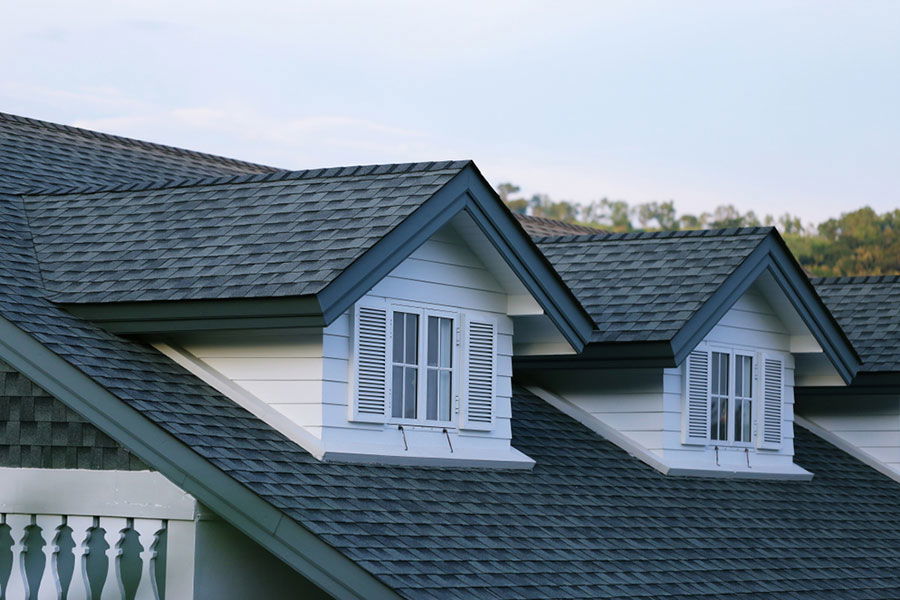Replacing a roof is one of the biggest expenses homeowners face. Costs typically range from $6,000 to $50,000, with the average homeowner spending around $11,000. The final price depends on factors like roof size, materials, and labor costs.

Waiting too long to replace a failing roof can lead to water damage, mold, and costly repairs inside your home. Planning ahead gives you time to compare quotes, explore financing options, and find the best deal.
Let’s break down what affects the cost of a new roof and how to manage your expenses.
Factors That Impact Roof Replacement Costs
Several factors affect the cost of replacing a roof. The materials, labor, and location all play a role in determining the final price.
Roofing Material
Different materials come with different price tags. An asphalt shingle roof is the least expensive, while metal, tile, and slate cost more but often last longer. Some materials also require specialized labor, increasing installation costs.
Roof Size and Complexity
The larger the roof, the more materials and labor will be needed. Roofs with steep slopes, multiple peaks, or intricate designs require more time and effort, which increases labor costs.
Labor Costs
Experienced contractors typically charge higher rates, but quality workmanship can prevent costly repairs later. Getting multiple quotes and checking reviews can help you find a fair price without sacrificing quality.
Location and Climate
Prices vary depending on where you live. Areas with a higher cost of living tend to have more expensive labor rates. Harsh weather conditions, such as hurricanes or heavy snowfall, may also require stronger materials, adding to the total cost.
Permits and Regulations
Some cities require permits for roof replacement, which can add to the overall expense. If you live in a historic district or an area with strict building codes, you may have additional material or labor requirements that increase costs. Checking local regulations before starting a project can help prevent unexpected fees.
Cost Breakdown by Roofing Material
When planning a roof replacement, understanding the costs associated with different materials is essential. Here’s a breakdown of common roofing materials and the average roof replacement cost for a typical 2,000-square-foot home:
| Roofing Material | Average Cost Range | Key Features |
|---|---|---|
| Asphalt Shingles | $8,000 – $17,000 | Budget-friendly and widely used |
| Metal Roofing | $14,000 – $30,000 | Durable, energy-efficient, and long-lasting |
| Tile Roofing (Clay/Concrete) | $15,000 – $40,000 | Long-lasting with a distinctive appearance |
| Slate Roofing | $19,000 – $52,000 | Premium material with exceptional longevity |
| Wood Shingles | $14,000 – $32,000 | Natural aesthetic but requires maintenance |
| Solar Roofing | Varies | High initial cost with potential energy savings |
Note: Costs can vary based on factors like location, roof complexity, and labor rates.
Asphalt Shingles: These are the most common and cost-effective roofing materials, making them popular among homeowners. They offer a decent lifespan, but may require replacement sooner than other materials.
Metal Roofing: Known for their durability and energy efficiency, metal roofs can last several decades. While the upfront cost is higher, they often require less maintenance over time.
Tile Roofing (Clay/Concrete): Tile roofs are appreciated for their longevity and distinctive look. However, they are heavier, so it’s important to ensure your home’s structure can support the weight.
Slate Roofing: As a premium roofing option, slate offers exceptional durability and a unique appearance. The higher cost reflects its longevity and aesthetic appeal.
Wood Shingles: Providing a natural and classic look, wood shingles require regular maintenance to prevent issues like rot or insect damage.
Solar Roofing: Solar roofing options vary widely in cost. While they have a higher initial investment, they can lead to energy savings over time.
When selecting a roofing material, consider factors such as your budget, desired aesthetic, and how long you plan to stay in your home. It’s also wise to consult with a professional roofing contractor to get personalized advice and accurate estimates based on your specific situation.
Signs You Need a Roof Replacement
A damaged roof can lead to expensive repairs if left unchecked. Spotting problems early can help you avoid water damage, mold, and higher replacement costs. Here are some key signs that it’s time for a new roof.
Leaks and Water Stains
If you notice water stains on your ceiling or walls, your roof may be leaking. Even small leaks can cause mold growth and structural damage over time. Checking your attic for damp spots after a rainstorm can help catch leaks early.
Curling, Missing, or Cracked Shingles
Shingles protect your home from the elements, but they don’t last forever. If they are curling, cracking, or falling off, your roof may no longer provide proper protection. Harsh weather, aging, and poor ventilation can speed up this damage.
Bald Spots Where Granules Are Missing
Asphalt shingles have a protective layer of granules that help deflect UV rays and extend their lifespan. If you see bald spots or granules collecting in your gutters, your shingles are wearing out and may need to be replaced.
Sagging Roof Structure
A sagging roof is a serious issue that could indicate structural damage. It may be caused by prolonged exposure to moisture, rotting wood, or foundation issues. If you see any signs of sagging, schedule an inspection immediately to prevent further damage.
Regular roof maintenance and inspections can help extend the life of your roof, but if you notice these warning signs, it may be time to consider a replacement.
How to Reduce Your Roof Replacement Costs
A new roof is a big investment, but there are ways to keep costs down without sacrificing quality. Planning ahead and exploring your options can save you thousands.
Hire a Roof Inspector First
Before committing to a full replacement, bring in an inspector. They can determine whether a full roof replacement is necessary or if a repair will do the job. A few hundred dollars for an inspection could save you from an unnecessary expense.
Compare Multiple Contractor Bids
Don’t settle for the first estimate you get. Reach out to at least three roofing contractors to compare pricing, warranties, and materials. Avoid bids that seem too low, as they may indicate poor workmanship or subpar materials.
Time It Right
Roofing companies are busiest in late spring and summer, which can drive up prices. If possible, schedule your project during the off-season, such as late fall or winter, when contractors may offer lower rates to secure work.
Check Homeowners Insurance
If your roof was damaged by a covered event, like a storm or fallen tree, your insurance policy might cover part or all of the replacement cost. Contact your provider to understand what’s included and what your out-of-pocket expenses will be.
Look for Discounts and Rebates
Some manufacturers and local governments offer rebates for energy-efficient roofing materials, such as cool roofs or solar shingles. Check with roofing suppliers and state energy programs to see if you qualify for any incentives.
Consider Partial Roof Replacement
If only part of your roof is damaged, you may not need a full replacement. A contractor can assess whether a partial replacement is a viable option, which could cut costs significantly.
Negotiate the Price
Many roofing contractors are open to price discussions, especially if you’re flexible with scheduling. Ask if there are any promotions, discounts, or package deals available. Some companies may lower the cost if you handle the old roof removal yourself.
A little research and planning can go a long way in reducing your roof replacement costs. Taking the time to explore these options can help you get the best value for your investment.
Financing Options for a New Roof
A roof replacement can be expensive, but there are several ways to finance the project without straining your budget. Exploring different options can help you find the best fit for your financial situation.
Home Improvement Loans
Home improvement loans are designed for renovation projects and typically offer fixed interest rates with structured monthly payments. They are available from banks, credit unions, and online lenders. Approval usually depends on credit score and income.
HELOC (Home Equity Line of Credit)
If you have built up equity in your home, a HELOC allows you to borrow against it. This option provides flexibility since you can withdraw funds as needed, but it comes with variable interest rates that may increase over time.
Roofing Company Financing
Many roofing companies offer in-house financing or work with third-party lenders to provide payment plans. These options can be convenient, but interest rates and terms vary, so it’s important to compare them with other financing choices before committing.
Insurance Coverage
If your roof was damaged by a covered event, such as a storm, fire, or falling debris, your homeowners insurance may cover part or all of the replacement cost. Contact your provider to understand your coverage and potential out-of-pocket expenses.
Weighing your financing options carefully can help make a roof replacement more manageable while ensuring you get the best deal possible.
How to Choose the Right Roofing Contractor
Hiring the right contractor is just as important as choosing the right roofing material. A poorly installed roof can lead to expensive problems down the road, so take the time to find a reliable professional.
Look for Licensed and Insured Professionals
A reputable roofing contractor should be licensed in your state and carry both liability insurance and workers’ compensation coverage. This protects you from potential legal or financial issues if something goes wrong during the project.
Check Online Reviews and Ask for Referrals
Reading reviews on Google, Yelp, and the Better Business Bureau can help you gauge a contractor’s reputation. Asking friends, family, or neighbors for recommendations is another great way to find a trustworthy roofer.
Request a Detailed Estimate with All Costs Upfront
A written estimate should outline labor, materials, permits, and disposal fees. Be wary of vague quotes or contractors who demand full payment upfront. Comparing multiple estimates can also help you spot overpriced or underpriced bids.
Ask About Warranties on Materials and Labor
Many roofing materials come with manufacturer warranties, but some contractors also offer guarantees on their workmanship. Understanding the warranty terms can help you avoid unexpected repair costs in the future.
Taking the time to vet roofing contractors properly can save you from headaches and costly mistakes. A reliable professional will provide quality work and peace of mind for years to come.
Bottom Line
Replacing a roof is a big investment, but it doesn’t have to be overwhelming. With costs ranging from $6,000 to $50,000, the best way to take control of the process is to plan ahead.
Start by researching materials and getting multiple quotes. The type of roofing you choose, the complexity of your roof, and labor costs will all play a role in the final price. A little extra effort now can save you thousands in the long run.
If your roof is showing signs of wear, don’t wait until leaks cause expensive damage inside your home. Explore financing options, check your homeowners insurance, and negotiate with contractors to get the best deal.
A well-installed roof isn’t just an expense—it’s an investment in your home’s value and protection. Take the time to make the right decisions now, and you’ll have peace of mind for years to come.
Frequently Asked Questions
How do different types of roofs affect the replacement cost?
The type of roof has a major impact on replacement costs. Asphalt shingles are generally the most affordable, while materials like metal, tile, or slate are more expensive. The complexity of the roof design, such as the presence of skylights or multiple levels, also affects the cost.
Are there any additional expenses associated with roof replacement?
Yes, there can be additional expenses beyond the basic cost of materials and labor. These might include costs for permits, structural repairs, gutter replacement, or disposal of the old roofing materials. These costs should be considered when budgeting for a roof replacement.
Does the size of the roof influence the cost?
Absolutely. The larger the roof, the more materials and labor will be needed, which increases the overall cost. Roofing costs are often calculated per square foot, so a larger roof area will result in a higher total cost.
What factors can affect the overall cost of a roof replacement?
Several factors can affect the total cost, including the type of roofing material, the complexity of the roof’s design, the need for structural repairs, local labor rates, and whether the old roof needs to be removed first. Weather conditions and seasonal demand can also play a role.
Is roof removal included in the replacement cost?
In many cases, the cost of removing the old roof is included in the roof replacement quote. However, this is not always the case, so it’s important to clarify this with the contractor. The cost of removal can vary depending on the size and material of the existing roof.
Do I need permits for a roof replacement?
Yes, most local governments require permits for a roof replacement. The cost and requirements for these permits vary by location. It’s important to factor in these costs and ensure that your contractor handles the permit process.
Are there any financing options available for roof replacement costs?
Many roofing contractors offer financing options to help manage the cost of roof replacement. Additionally, some banks and credit unions offer home improvement loans. It’s advisable to compare rates and terms to find the best financing solution.
What are some signs that indicate a need for a roof replacement?
Signs that you may need a roof replacement include missing or damaged shingles, frequent leaks, sagging, and daylight visible through the roof boards. If the roof is more than 20 years old, it might also be time to consider replacement.
How long does a typical roof replacement take?
The time required for a roof replacement can vary, but most projects are completed within a few days to a week. Factors that influence the timeline include the size of the roof, weather conditions, and the complexity of the job. More complex projects or unforeseen issues can extend this timeline.
How much can I save by replacing my roof myself?
DIY roof replacement can lead to significant savings, primarily by eliminating professional labor costs. You may also reduce expenses by sourcing materials and handling waste disposal yourself.
However, while DIY can cut initial costs, you need to consider the value of professional workmanship, which often ensures quality and adherence to safety standards. Inexperienced DIY attempts might lead to costly future repairs, potentially offsetting the initial savings.




